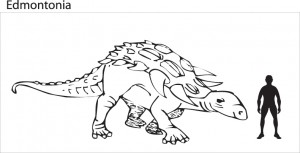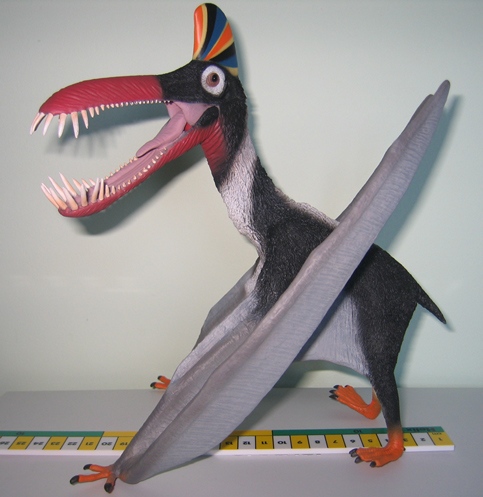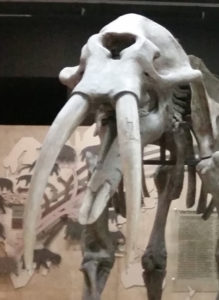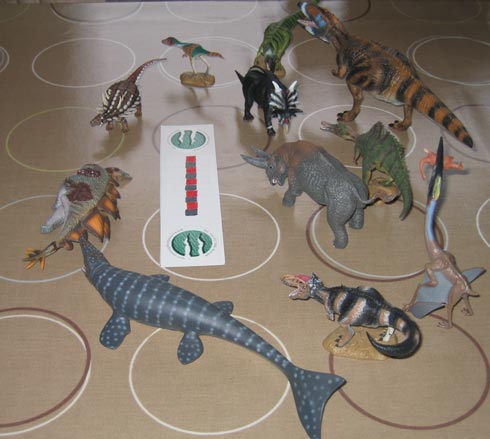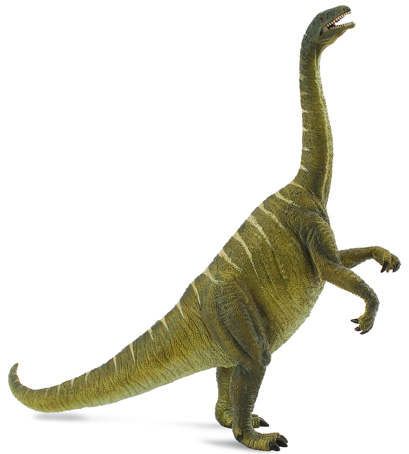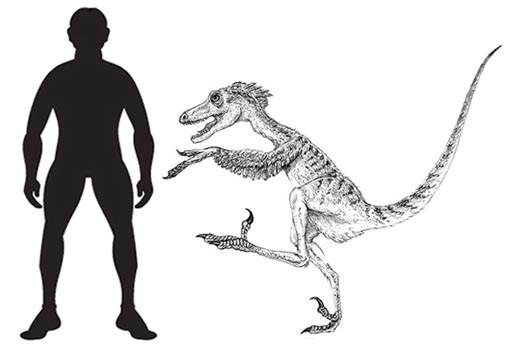New Dinosaur Themed Board Game – Dino-opoly
Amongst all the usual jobs we have of running a company, dealing with suppliers, sorting out new printer cartridges for the office printers (a perennial task), office administration and so on we do have some really interesting and fun things to do.
Dinosaur Dino-opoly
One fun thing and a favourite of ours is checking out new products to add to our shop. These days we get lots of approaches from manufacturers and designers with requests for Everything Dinosaur to stock their new line, sometimes we get bombarded with offers and e-mails. When we first started we all agreed that parents and children would make the best stock control officers. None of us have a lot of experience of retailing toys and games, after all most of us come from a teaching or science background so we thought why not let the customers have a say as to what products and services we sell?
We are lucky, one of our team members has had quite a lot of experience with setting up Hall tests and focus groups, which involve inviting groups of parents and children (and the occasional aunt, uncle and grandparents), to a village hall or hotel room and testing out new products.
Everyone is involved in supervised play, Often to help these events run smoothly refreshments are brought along. The dinosaur biscuits and cakes that we make help keep a prehistoric theme. The recipes are available on our weblog and they are quite easy to make (even I have had a go). We thought it would be a good idea to post up some recipes for dinosaur themed cakes and biscuits so that parents could make some of the food for dinosaur parties and such like. They have proved to be very popular and this part of the Everything Dinosaur blog is one of the most visited according to our site statistics.
Search our blog using terms such as “cake”, “biscuit” and “party” for lots of helpful articles, recipes and ideas.
Lots of Dinosaur Themed Recipes and Party Food Ideas can be Found on the Everything Dinosaur Blog

Dinosaur recipe ideas – dinosaur themed cakes, biscuits and other snacks, visit the Everything Dinosaur blog.
Picture credit: Everything Dinosaur
Involving All Team Members with our Plans
The Hall tests and focus groups take a bit of planning, it is important to involve all the team members in the preparations, but after doing so many most people are quite comfortable organising them and become quite professional, even if we say so ourselves. New products and items are selected for testing, it is best to divide them up into clearly defined age group categories and after a brief warm up session (called an ice-breaker), to get everyone relaxed, the testing can begin and feedback gathered.
We have designed a questionnaire that is mostly tick-box (Sue calls these closed-ended questions) but there are spaces for respondents to provide a bit more detail and information. These questionnaires are then filled out and once collected and reviewed they provide valuable information. We have used the FREEPOST forms and envelopes to get feedback as well. We used to send out these feedback forms to our customers with every purchase. This is a form of market research and it did provide us with important insights into what might sell well and what items we should avoid.
Sometimes the testing process takes us to some funny places, for example when we introduced the Dinosaur Backpacks we took a group of parents and children to the local zoo for the day to see if the backpacks would stand up to a “rigorous field test”. We sponsored the crocodiles at the zoo so we got some discounted tickets and off we all went with the children carrying their lunches and drinks in their Dinosaur Backpacks. Everyone had a good time, even the crocodiles seemed pleased to see us. The feedback we received from our “Backpack road test” was so positive that we added this item to our shop. One 8-year-old girl pointed out that as the backpack was soft and cuddly she wanted to use it as a nightie case. None of us had thought of this, the zipped pocket in the back was ideal for storing pyjamas and nighties so in addition to selling the backpack as a conventional children’s’ outdoor pack we added the bit about using it as a pyjama case – clever girl!
Visit Everything Dinosaur to view our products: Visit the Everything Dinosaur Website.
Feedback from customers is very important to us. Fortunately, we get lots and lots of helpful comments and suggestions. The questionnaires are supplemented by the comments made to the team about the products, mail order and shopping on-line generally when we get the chance to mingle. We often get some very good insights that would have been missed had we relied solely on the questionnaires. The development of our dinosaur toy tidy came out of one such off the cuff remark, made by a Mum who was tired of picking up her little boys toy dinosaurs from the bedroom floor.
Anyway, one of our recent testing sessions involved trying out a new board game based around learning about dinosaurs. The game is called “Dino-opoly” and is a variation on a traditional board game, except you don’t purchase houses and hotels but dinosaur bones to put into your museum. The game was devised in the USA (hence all the rents and fines are in dollars) but they have chosen a wide range of dinosaurs to feature in the game from tiny Compsognathus right up to the huge Sauroposeidon and Seismosaurus.
New Dinosaur Dino-poly Board Game
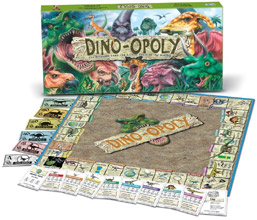
Picture courtesy of Everything Dinosaur and Sudhir (thank you Sudhir)
The game has been designed for 2 to 6 players and the box instructions says that it for children 8 years to adult, but we found that dinosaur fans as young as six took to it and soon were telling us how to play!
Choose your character, not the boot, the car or the Scottie dog that we were used to but shiny silver counters decided especially for dinosaur fans. You could choose from a Stegosaurus, pick-axe, a T. rex skull, a baby dinosaur hatchling an enormous raptor claw or a Trilobite. Taking turns, you roll the dice and proceed round the board but in this version you have to pass “Dig” before you can collect $200 for supplies and “Chance” and “Community Chest” have been replaced by two different sets of cards called “Discover” and “Explore”. Fortunately, there is no Jail and no get out of jail card, this has been replaced with a “nearly extinct” square so the creators of the game have really thought about how the game should be put together.
We liked the variety of dinosaurs that the designers had chosen to feature in the game (on the back of every dinosaur deed, there is information about the particular animal which was cool. The Mums and Dads were very impressed when their children were able to pronounce the names of the new dinos they had not heard of before.
The most valuable exhibit on the board is not Tyrannosaurus rex, that honour in this dinosaur dino-opoly board game goes to Giganotosaurus at a whopping $425 (if only the real fossils were so cheap)!
All in all, the game got a big thumbs up, it is an interesting variation on traditional family board games with the bonus of lots of dinosaur facts and information to keep the youngsters informed as well as entertained. There is even a whizz round the board 1-hour quick play version for those dinosaur buffs who want to play hard and fast with dinosaur evolution.





